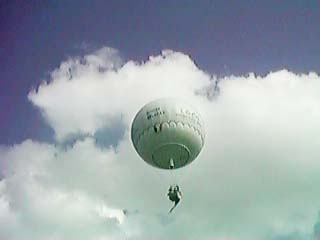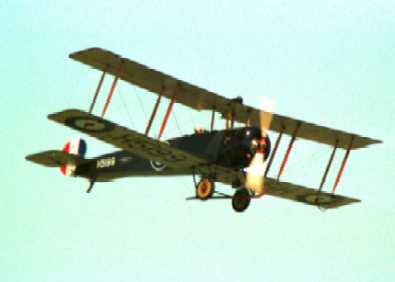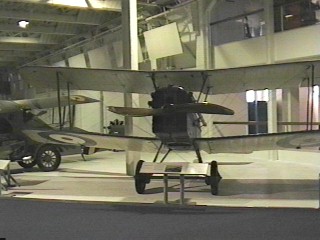
a gas balloon similar to those used at Farnborough
In the early years of the 20th century Farnborough was a small,sleepy town in southern England. All that was to change over the next ten years.
Military aviation in the UK has its origins in ballooning.Ballooning was not much more that a fete and country show act,and was not taken seriously. It was first seriously used in warfare during the American Civil war. After a fact finding visit by officers of the Royal Engineers it was recommended that experiments should be carried out in the UK.These were carried out at the Royal Engineers H.Q. at Chatham,Kent.
The first flights by military balloon were carried out at Chatham in August 1878.A hand full of small observation balloons were built over the next few years. These took part in several exercises at the home of the British army,Aldershot.It was therefore decided to move the Royal Engineers to Aldershot,where a balloon factory and school were founded. Small scale operations were carried out during the Boare War in South Africa. By 1903 the factory had grown out of its Aldershot site,and required relocation. It was relocated during the winter of 1904/05 to the current site in Farnborough. At the time this was a large open area know as Farnborough common. Now experiments with airships could take place.The first of these was the Nulli Secundus in September 1907.Trials with this,and later airships continued until the start of World war one,when responsibility for airships was handed over to the Royal Navy.

By the foundation of the Farnborough site an American Samuel Franklin Cody had begun experiments in the UK. He firstly experimented with large man lifting kites.He was employed by the balloon factory as instructor of kiting in 1907. He turned his focus to powered flight.Although the Wright brothers had flown in 1903, still nobody had flown a powered aircraft in the UK.Cody first experimented with gliders at Farnborough during 1907.With war Office backing Cody constructed British Army Aeroplane Number 1.This aircraft made the first powered flight in the UK on 16th October 1908.By 1909, despite continuing success,the War office withdrew its support.Although Cody could continue to used Farnborough,and was still Instructor of Kiting.Until 1913 Cody made several different Aircraft. He was killed on 7th August 1913 when his latest model crashed in the North West corner of the Airfield,killing Cody and his passenger. The unofficial balloon factory became His Majesty's Balloon Factory on 1st April 1908.In October 1910 the factory became responsible for all military aeronautical research and development.By this time the War Office had changed its mind and was again supporting Powered flight.This time also saw the first wind tunnels at Farnborough.Geoffery de Havilland was employed as chief designer and test pilot.While at Farnborough he designed the first practical aircraft for the RAF,starting with the BE2..At this time the aerodrome occupied a small area opposite what now is Farnborough collage.It consisted of a couple of large airship sheds,smaller sheds for aircraft and associated workshops and barracks.
The Royal Flying Corps(RFC) was formed in April 1911 at Farnborough.The first 7 squadrons were all formed at Farnborough between 1912 and 1914.The HQ building still stands opposite the row of shops on Farnborough Road near the Swan pub.The aircraft were housed in the famous 'black sheds' situated at what is now the end of Runway 25. At the start of World War One the based RFC squadrons embarked for France to find their aircraft not up to the task.Aircraft designed at Farnborough were rushed into production at sub contractors across the country. Farnborough officially becoming the Army Aircraft Factory.These were mainly the BE2c and FE2,powered by the locally designed RAF engines. Also the factory became responsible for the repair of damaged aircraft and the evaluation of foreign types and captured enemy aircraft. It was at this time that employment in the factory boomed,and the start of the growth of the town started. Many of the wars most famous aircraft were designed at Farnborough such as the SE5a,and the RE series of reconnaissance aircraft.After claims by the aircraft industry that it was unfair for Farnbrough to evaluate their products and design their own,it was decided that Farnborough would concentrate on research only.

